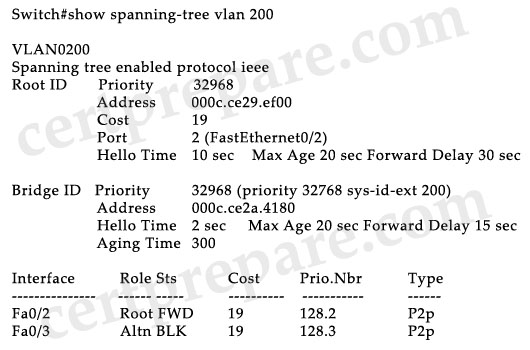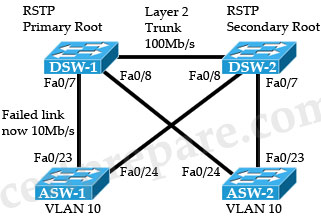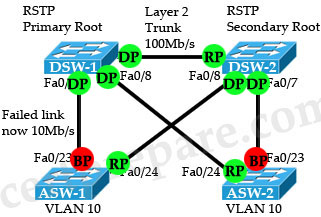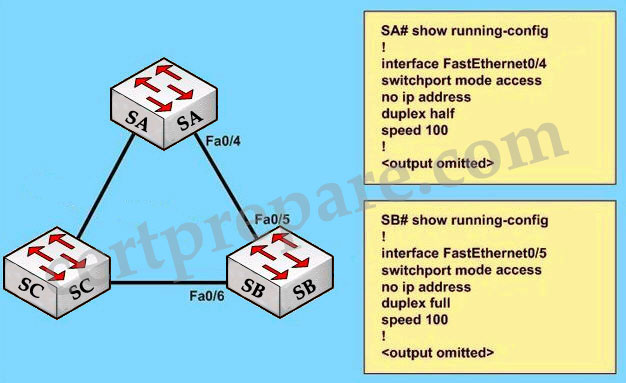STP Questions 6
Here you will find answers to STP Questions – Part 6
Question 1
Based on the show spanning-tree vlan 200 output shown in the exhibit, which two statements about the STP process for VLAN 200 are true? (Choose two)

A. BPDUs will be sent out every two seconds.
B. The time spent in the listening state will be 30 seconds.
C. The time spent in the learning state will be 15 seconds.
D. The maximum length of time that the BPDU information will be saved is 30 seconds.
E. This switch is the root bridge for VLAN 200.
F. BPDUs will be sent out every 10 seconds.
Answer: B F
Explanation
From the output you learn that:
+ This is not the root bridge for VLAN 200 (it does not have the line “This bridge is the root” and the root bridge information is shown first. It has a Alternative port).
+ The root bridge is sending Hello every 10 seconds, Max Age is 20 seconds and Forward Delay is 15 seconds while the local bridge is sending Hello every 2 seconds, Max Age is 20 seconds and Forward Delay is 15 seconds.
Aan IEEE bridge is not concerned about the local configuration of the timers value. The IEEE bridge considers the value of the timers in the BPDU that the bridge receives. Effectively, only a timer that is configured on the root bridge of the STP is important. In this case, the local switch will import STP timers from the root bridge -> The listening state (or learning state) will be 30 seconds, which equals to Forward Delay. Also BPDUs will be sent out every 10 seconds (Hello packets).
(Reference: http://www.cisco.com/en/US/tech/tk389/tk621/technologies_tech_note09186a0080094954.shtml)
Question 2

All links in this network are layer 2, fast Ethernet 100 Mb/s and operating as trunks. After a failure, the link between ASW-1 and DSW-1 has incorrectly come back up at 10 Mb/s although it is connected.
Which one of the following will occur as a result of this failure?
A. There will be no change to the forwarding path to traffic from ASW-1
B. ASW1 will block Fa0/24 in order to maintain the shortest path to the root bridge DSW-1
C. ASW-1 will block Fa0/23 in order to maintain the shortest path to the root bridge DSW-1
D. ASW-1 will elect DSW-2 as the root primary since it is close than DSW-1
Answer: C
Explanation
The picture below shows the port roles of all ports when the topology is converged after the failure.

RP: Root Port
BP: Blocked Port
DP: Designated Port
Question 3
Regarding the exhibit and the partial configuration of switch SA and SB. STP is configured on all switches in the network. SB receives this error message on the console port:
00:06:34: %CDP-4-DUPLEX_MISMATCH: duplex mismatch discovered on FastEthernet0/5 (not half duplex), with SA FastEthernet0/4 (half duplex), with TBA05071417(Cat6K-B) 0/4 (half duplex).
What would be the possible outcome of the problem?

A – The root port on switch SB will fall back to full-duplex mode.
B – The interfaces between switches SA and SB will transition to a blocking state.
C – The root port on switch SA will automatically transition to full-duplex mode.
D – Interface Fa0/6 on switch SB will transit to a forwarding state and create a bridging loop.
Answer: D
Explanation:
From the output, we learned that the interfaces on two switches are operating in different duplex modes: Fa0/4 of SA in half-duplex mode & Fa0/5 of SB in full-duplex mode. In this case, because SB is operating in full duplex mode, it does not check the carrier sense before sending frames (CSMA/CD is not used in full-duplex mode). Therefore, SB can start to send frames even if SA is using the link and a collision will occur. The result of this is SA will wait a random time before attempting to transmit another frame. If B sends enough frames to A to make every frame sent from A (which includes the BPDUs) get dropped then SB can think it has lost root bridge (B does not receive BPDUs from A anymore). Therefore SB will unblock its Fa0/6 interface for transmitting and cause a bridging loop.


